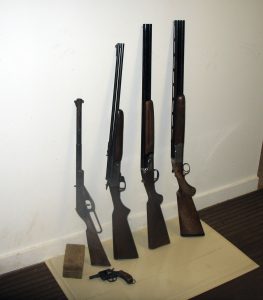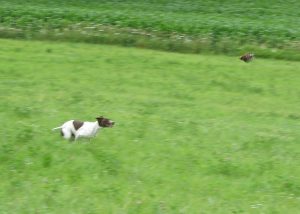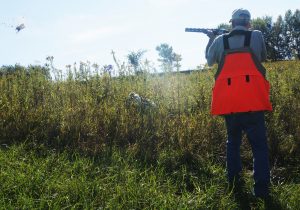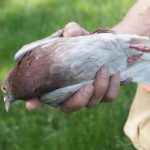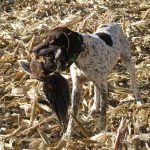Dos and Don’ts of Gun Development
POINTING DOG POINTERS
By Bob and Jody Iler
In the past two columns, we’ve talked about types of birds to use in training and how to plant those birds. When it comes to gun development, the most crucial prerequisite is the pup’s development and performance on birds. We don’t even think about the gun until and unless our pup is bird crazy and hunting with enthusiasm.
Some pups are blessed with this in their genetics. They eat, sleep and dream birds! We have an English setter pup like this. If it has wings, it has her undivided attention to the exclusion of everything else! We can’t develop this in pups—they either have it or they don’t. Of course, there are varying stages in between, from the dog who shows no interest whatsoever in a bird to the one who is mildly or considerably interested and can be brought along with patience and exposure to birds to mature into a fairly good hunting dog.
Over the years we’ve developed many pointing dogs to the gun—some much easier than others. Though we use a structured program, we adapt it to each student, depending primarily on the pup’s birdiness and temperament. Often we need to adjust the program to the pup’s reactions when we introduce noise to his training.
Almost as important in gun development is our pup’s temperament, but this is a variable that can depend, again, on a pup’s birdiness. We’ve had shy, soft pups that were extremely bird crazy and were easy to develop to the gun because of their focus on the birds. By the same token, a shy or timid pup that has not learned to love birds and hunting will likely be intimidated by any noise you introduce that is associated with birds.
If you’re new to pointing dogs, it’s key to remember that, unlike flushing dogs, your pup will be standing still, pointing a bird, before you flush and shoot the bird. Because he’s not rushing in on the bird to flush it, the pointing dog will naturally be more aware of the sound of the gun.
It’s good to keep this in mind—you don’t want your pup to even NOTICE the gun when you shoot. Accomplishing this will take time, patience and awareness of your dog’s reactions. Pointing dogs aren’t born broke to the gun, and we’ve had many a gun shy dog at our kennel. Some we were able to help, others not.
Here are some do’s and don’ts for you to keep in mind as you develop a plan for training your new pointing dog pup.
DO:
- Focus on getting your pup bird crazy and chasing birds before introducing any level of noise to his program.
- Always work with a slow progression of noise, starting with a popgun or clapping blocks together, as he chases a bird. Progress to the 22, then 32 caliber guns, then the 410, 20 gauge and 12 gauge—take as long a period of time that is needed to ensure that pup pays no attention to the noise.
- Initially keep the noise at a distance from pup as he chases birds. Move the noise closer as he pays no attention to it. Enlist a helper if needed as you handle your pup.
- If pup reacts to noise at any level, stop and go back a step or two.
- Once your dog is developed to the gun, go slow and sensible in his first hunting season. One or two shots per bird are plenty at one time for the young dog, and no more than two or three birds per session.
- In his first season, hunt your pup alone for a while before hunting with a companion. And when you do hunt with a buddy, take turns shooting so you don’t overdo it with the young dog.
- If a problem develops, address it immediately. Don’t let it get worse!
DON’T:
- Never take your pup to a shooting/trap range to “desensitize” her to noise!
- Never restrain your pup by tying her to a tree or putting her in a car/crate and then shooting nearby.
- Don’t let your pup be closely exposed to fireworks and firecrackers, etc.
- Avoid preventable loud noises such as slamming doors, etc. around your pup, but don’t coddle and comfort a pup during thunderstorms or for an unavoidable noise. Instead, be calm and matter of fact and act nonchalant, not overprotective.
- When hunting, don’t shoot a bird that your young dog is not working, such as a wild flushed bird that she does not see.
- Don’t restrain or steady your young dog to wing or shot at this stage.
- Remember that your goal is to have the pup focused on the bird by letting her chase, oblivious to the sound of the gun.
- Don’t rush your pup through the stages of gun development. Watch her reactions at each level and adjust accordingly.
- Avoid the advice of others if it goes against your “gut!” You know your dog and you have plenty of time to develop her on her own timetable!
We feel that it’s always better to err on the side of caution when it comes to gun development. We’ve had gun shy dogs come to our kennel that ran out of the field at the sight of the gun, cowered at the sound of a 22, and quit hunting at the first report of a shotgun.
We can say with conviction and from experience that it’s much easier to develop your pup in a gentle, step-by-step program than it is to undo the damage done by improper gun development. If you train with awareness and patience according to the response your pup gives you at each stage of her training, you’ll have a pointing dog that will hunt with enthusiasm and confidence as your partner in the field!
Pointing Dog Pointers features monthly training tips by Bob and Jody Iler, who own Green Valley Kennels in Dubuque, Iowa. Bob and Jody have trained pointing dogs for over 35 years and have written many articles for Pointing Dog Journal.



